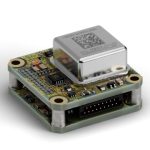Santa Clara, CA-based startup Anello Photonics has announced a GNSS INS module that it says is the world’s smallest optical gyro inertial navigation system for GPS-denied navigation and localization. It is powered by the company’s optical gyroscope technology and AI-based sensor fusion engine, the combination engineered to deliver high-accuracy positioning and orientation for applications in the agriculture, construction, robotics, and autonomous vehicle space.
“We are actively engaged with customers who need robust, high-precision optical gyro-based solutions for their autonomous applications,” said Dr. Mario Paniccia, CEO of Anello Photonics.
Anello was co-founded by Paniccia and CTO Mike Horton, pioneers in the field of silicon photonics, sensors, and navigation, with the early support of Catapult Ventures and high-volume fab Tower Semiconductor. Coming out of stealth at CES 2023, Anello displayed the low-noise and -drift SiPhOG™ sensor, which it says is the first silicon photonics optical gyroscope and the smallest optical gyroscope in the world.
“It was a very ambitious thing we took on—creating a fiber gyro on a chip,” Paniccia to Inside GNSS. “We’re measuring a very tiny signal and putting it all into a standard process that’s fabricated in a high-volume fab. To our knowledge, no one’s building or has anything working at this level, let alone full INS systems, with integrated photonics.”
According to Anello, the silicon photonics optical gyroscope technology can be board-mounted and is made with integrated photonics components so it can be processed in high volume just like other integrated circuits. Another key advantage is a low unaided heading drift of less than 0.5°/h.
“This is the sweet spot,” said Paniccia. The MEMS in mobile phones and AirPods—which range from 2.0°/h, with high temperatures pushing that to hundreds and potentially a thousand degrees per hour—are not accurate enough for the autonomy safety case, he added. Typical fiber gyros, “the gold standard” for accuracy, are too big, bulky, and expensive.
“The idea is to bring the performance of high-precision optical gyros from guided missiles and other high-end applications into a form factor and price point that you can put it into the volume market in the autonomous landscape,” he said.
For the new GNSS INS system, the company launched an evaluation kit about a year ago for customer trials.
“It’s the smallest in this case, [with] not only the smallest gyro that we’ve developed and announced but now we have the smallest inertial navigation system that can be put into real solutions and real applications,” said Paniccia.
The near-term markets for Anello’s technology are in construction and farming “where they can pay a little bit of a premium.” An upcoming robotics product uses basically the same core fundamental platform without GPS.
In the future, the company is working to deliver to the high-volume auto market, and that means not only ASIL-D specs but also immunity to temperature and vibration with lower power consumption.
“We’re trying to gear towards ADAS (L2 plus, L3) over time,” concluded Paniccia.






